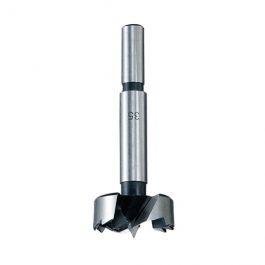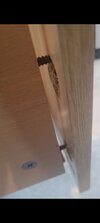You are using an out of date browser. It may not display this or other websites correctly.
You should upgrade or use an alternative browser.
You should upgrade or use an alternative browser.
What can i do to fix this drawer?
- Thread starter fitzykev
- Start date
D
Deleted member 174758
The problem is that glue isn't a gap filler, which is also needed. You could try a 2-pack filler (wood filler or car body filler) to fill the damaged areas, but I'm not sure how long that fix alone would work, especially if the drawer is heavily laden. Were it me I'd use the 2-pack to fill the holes (push the fixings intonthe 2-pack whilst it is soft) PLUS add a couple of angle repair plates between the drawer sides and the drawer front on the inside of the drawer
- Joined
- 7 Sep 2022
- Messages
- 2,764
- Reaction score
- 708
- Country

And then see if you can fit a soft close; the weight of the drawer base and the things in the drawer will constantly strive to wrench the base off the front (as it has done here) when it bangs shut. The more you can make it slow to a stop before the face comes into contact with the cabinet the less likely that will happen.
- Joined
- 7 Jan 2010
- Messages
- 13,270
- Reaction score
- 3,214
- Country

Corner brackets with screws short enough not to pierce the drawer front?


HEAVY DUTY REINFORCED GALVANISED ANGLE L BRACKETS CORNER BRACE TIMBER 2,0mm T | eBay
Find many great new & used options and get the best deals for HEAVY DUTY REINFORCED GALVANISED ANGLE L BRACKETS CORNER BRACE TIMBER 2,0mm T at the best online prices at eBay! Free delivery for many products.
www.ebay.co.uk
- Joined
- 7 Sep 2022
- Messages
- 2,764
- Reaction score
- 708
- Country

DiyNutJob, is that you? 
An alternative would be to use new cam fittings
 www.screwfix.com
www.screwfix.com
You would need to ignore the existing ones and fit new ones.
I have only ever used them once. I had to b'stardise a worktop for a mate that wanted the worktop to have a return to the floor (as an end panel).
I spent quite a while marking out though. If the cam lock was slightly too close to the edge, when tightened, it distorted the meeting edge.
I ended up spending about £10 on a 15mm bosch lip and spur bit because I found spade bits deviated too much, and in your case a spade bit will pop through the front of the door.
I did have to mock up a few bits of timber before finding the correct hole positions.
My option is not the cheapest but it replicates the original set up.
However it will cost close to £20 and require you to have access to scrap bits of timber.
Cam Dowels & Locks | Furniture Fixings | Screwfix
Buy Cam Dowels & Locks at Screwfix.com. Delivery 7 days a week Choose from top trade brands. Free next day delivery available. Products reviewed by the trade and home improvers.
You would need to ignore the existing ones and fit new ones.
I have only ever used them once. I had to b'stardise a worktop for a mate that wanted the worktop to have a return to the floor (as an end panel).
I spent quite a while marking out though. If the cam lock was slightly too close to the edge, when tightened, it distorted the meeting edge.
I ended up spending about £10 on a 15mm bosch lip and spur bit because I found spade bits deviated too much, and in your case a spade bit will pop through the front of the door.
I did have to mock up a few bits of timber before finding the correct hole positions.
My option is not the cheapest but it replicates the original set up.
However it will cost close to £20 and require you to have access to scrap bits of timber.
D
Deleted member 174758
Why not a Forstner bit, @opps? They generate a flat bottom hole and the centre point should be less obtrusive than the centre point on a lip and spur twist bit. Axminster used to do decent quality affordable Forstners which are a lot better than those Chinese TCT abominations which you see everywhere
Why not a Forstner bit, @opps? They generate a flat bottom hole and the centre point should be less obtrusive than the centre point on a lip and spur twist bit. Axminster used to do decent quality affordable Forstners which are a lot better than those Chinese TCT abominations which you see everywhere
Valid question. I was drilling in to a 45(?mm) worktop, so the point on the bit wasn't an issue.
On reflection... I didn't even think of a Forstner.
As an aside, and not relevant in this case, isn't a forstner more likely to deviate if drilled deeper? I am thinking of cases when you use dowels.
The 15mm lip and spur was used to drill a total of 3 holes but is was well worth the money (at £3 per hole). I was drilling in to iroko. The 15mm spade bits ended up cutting 16(?) holes. It may sound silly but it could make the difference of 0.5/1.0 mm at the cam/screw end
The drill bit was well worth the money though, forstners aside.
D
Deleted member 174758
Forstner bits are guided by their rims in the main (the tiny point most of them have is really only there to allow you to start the bit without having it skate across the workpiece). This therefore limits the depth you can drill with them, typically only 10 to 20mm. Go much deeper than the depth of the sidewalls and they start to choke as well as run off line. In fact, below 10 or 12mm diameter I really wouldn't bother with them as the tendency of the smaller sizes to choke is really frustratingAs an aside, and not relevant in this case, isn't a forstner more likely to deviate if drilled deeper? I am thinking of cases when you use dowels.
I think that spade bits are not really designed for accurate working; they are really and truly quick and dirty carpentry tools, so it doesn't surprise me that a so-called 15mm spade might be producing 16mm holes (although it is as likely that the problem results from the centre point being off centre as it is from the the bit body being incorrectly ground). Might I ask what brand of spade bit you were using?The 15mm spade bits ended up cutting 16(?) holes. It may sound silly but it could make the difference of 0.5/1.0 mm at the cam/screw end
There is a flip side to this, though. Spade bits (other than those horrible Bosch jobbies with a screw nose) can be reground into all sorts of shapes for special purposes, such as drilling tapered holes, etc. It's as well to remember that they work by a scraping sction, so they do get hot in use, have difficulty coping with knotsand go blunt relatively easily (making them less suitable for drilling in hardwoods). That said they are easily resharpened with a fine file or oolstone slip
Forstner bits are guided by their rims in the main (the tiny point most of them have is really only there to allow you to start the bit without having it skate across the workpiece). This therefore limits the depth you can drill with them, typically only 10 to 20mm. Go much deeper than the depth of the sidewalls and they start to choke as well as run off line. In fact, below 10 or 12mm diameter I really wouldn't bother with them as the tendency of the smaller sizes to choke is really frustrating
I think that spade bits are not really designed for accurate working; they are really and truly quick and dirty carpentry tools, so it doesn't surprise me that a so-called 15mm spade might be producing 16mm holes (although it is as likely that the problem results from the centre point being off centre as it is from the the bit body being incorrectly ground). Might I ask what brand of spade bit you were using?
There is a flip side to this, though. Spade bits (other than those horrible Bosch jobbies with a screw nose) can be reground into all sorts of shapes for special purposes, such as drilling tapered holes, etc. It's as well to remember that they work by a scraping sction, so they do get hot in use, have difficulty coping with knotsand go blunt relatively easily (making them less suitable for drilling in hardwoods). That said they are easily resharpened with a fine file or oolstone slip
Cheers.
TBH the only forstners I have ever used are the 35mm ones for cupboard hinges. The best one I have used is the Makita one

Makita Forstner Bit Concealed Hinge Cutter 35mm
Shop Makita Forstner Bit Concealed Hinge Cutter 35mm online or visit us in-store at Leyland SDM. Next day delivery available.
I can't remember which brand of spade bit I was using. On the balance of probability, it was either a regular Bosch or a no name.
Why do you dislike the Bosch ones with the screw nose? I was using one last week to drill the spindle holes on door mortice locks. The Howden doors are MDF cores with a parameter of chipboard and then timber (with MDF faces). No idea why they weren't just MDF and timber... TBF, the Bosch bit only had to go through a bit of MDF and then chipboard ( 8mm in total).
D
Deleted member 174758
The screw nose means that they pull in very quickly. The problem with that is you can end up spelching the fibres around the outside of the hole, which on a coarse grained timber like oak that just creates problems for you. They might be OK when they are new (and sharp), but they aren't new forever. The more traditional spade bit with an (unthreaded) awl point has the advantage (to mind) of having a sharpenabke awl point and sharpenable nickers at the outside of the cutting edge (a spade bit with sharp nickers can be used to score the veneer, before you drill - not all spade bits have nickers). The downside to non screw poi nt bits is that they are harder work because you have to push all the time you are drillingWhy do you dislike the Bosch ones with the screw nose?


